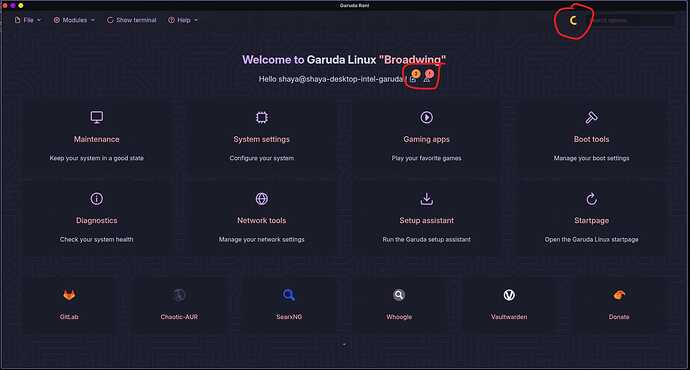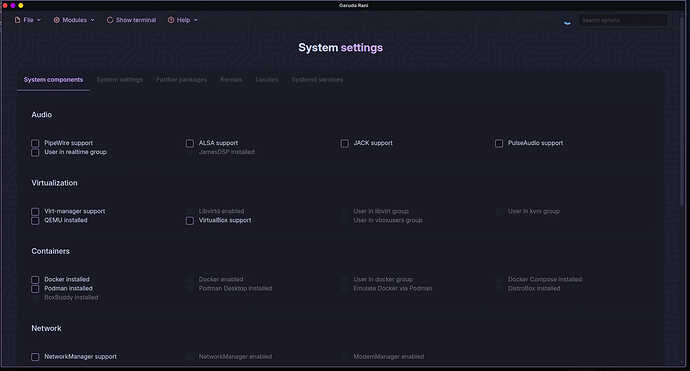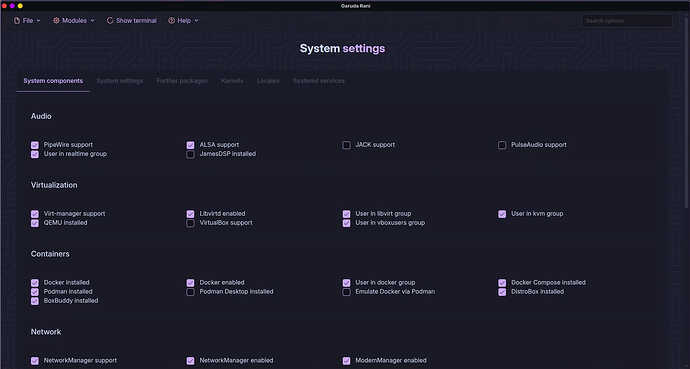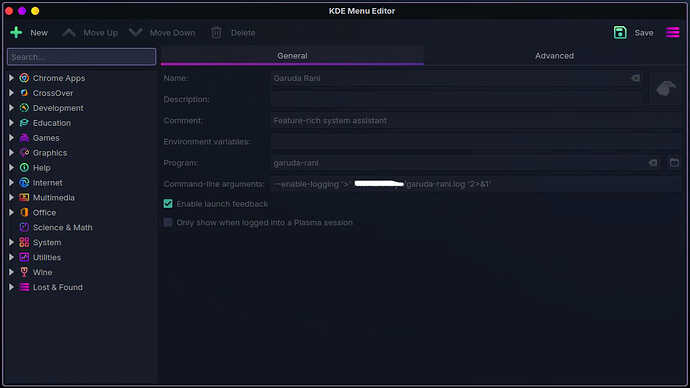First off, here’s my garuda-inxi:
System:
Kernel: 6.15.4-zen2-1-zen arch: x86_64 bits: 64 compiler: gcc v: 15.1.1 clocksource: tsc
avail: acpi_pm parameters: BOOT_IMAGE=/@/boot/vmlinuz-linux-zen
root=UUID=8dcc0c9c-8fe9-4fc6-b189-a8db2cfa3823 rw rootflags=subvol=@ rd.driver.pre=vfio-pci
intel_iommu=on i915.enable_guc=3 i915.max_vfs=7 quiet
resume=UUID=a14a443b-9c6b-47d0-b49a-d9686d767b7c loglevel=3 sysrq_always_enabled=1
split_lock_detect=off nvidia-drm.modeset=1 pci=disable_acs_redir=pci:12D8:2308
vt.default_red=30,243,166,249,137,245,148,186,88,243,166,249,137,245,148,166
vt.default_grn=30,139,227,226,180,194,226,194,91,139,227,226,180,194,226,173
vt.default_blu=46,168,161,175,250,231,213,222,112,168,161,175,250,231,213,200 ibt=off
Console: pty pts/1 DM: SDDM Distro: Garuda base: Arch Linux
Machine:
Type: Desktop System: ASUS product: N/A v: N/A serial: <superuser required>
Mobo: ASUSTeK model: PRIME Z690-P WIFI v: Rev 1.xx serial: <superuser required> part-nu: SKU
uuid: <superuser required> UEFI: American Megatrends v: 3601 date: 10/14/2024
CPU:
Info: model: 12th Gen Intel Core i9-12900K bits: 64 type: MST AMCP arch: Alder Lake gen: core 12
level: v3 note: check built: 2021+ process: Intel 7 (10nm ESF) family: 6 model-id: 0x97 (151)
stepping: 2 microcode: 0x3A
Topology: cpus: 1x dies: 1 clusters: 10 cores: 16 threads: 24 mt: 8 tpc: 2 st: 8 smt: enabled
cache: L1: 1.4 MiB desc: d-8x32 KiB, 8x48 KiB; i-8x32 KiB, 8x64 KiB L2: 14 MiB
desc: 8x1.2 MiB, 2x2 MiB L3: 30 MiB desc: 1x30 MiB
Speed (MHz): avg: 800 min/max: 800/5100:5200:3900 scaling: driver: intel_pstate
governor: performance cores: 1: 800 2: 800 3: 800 4: 800 5: 800 6: 800 7: 800 8: 800 9: 800
10: 800 11: 800 12: 800 13: 800 14: 800 15: 800 16: 800 17: 800 18: 800 19: 800 20: 800
21: 800 22: 800 23: 800 24: 800 bogomips: 152985
Flags: avx avx2 ht lm nx pae sse sse2 sse3 sse4_1 sse4_2 ssse3 vmx
Vulnerabilities: <filter>
Graphics:
Device-1: Intel AlderLake-S GT1 vendor: ASUSTeK driver: i915 v: kernel alternate: xe arch: Xe
process: Intel 10nm built: 2020-21 ports: active: none empty: DP-1,HDMI-A-1,HDMI-A-2
bus-ID: 00:02.0 chip-ID: 8086:4680 class-ID: 0300
Device-2: NVIDIA GA104 [GeForce RTX 3060 Ti Lite Hash Rate] vendor: ASUSTeK driver: nvidia
v: 575.64 alternate: nouveau,nvidia_drm non-free: 550-570.xx+ status: current (as of 2025-04;
EOL~2026-12-xx) arch: Ampere code: GAxxx process: TSMC n7 (7nm) built: 2020-2023 pcie: gen: 1
speed: 2.5 GT/s lanes: 16 link-max: gen: 4 speed: 16 GT/s ports: active: none off: DP-2,DP-4
empty: DP-3,HDMI-A-3,HDMI-A-4 bus-ID: 01:00.0 chip-ID: 10de:2489 class-ID: 0300
Device-3: Microsoft LifeCam Studio driver: hid-generic,snd-usb-audio,usbhid,uvcvideo type: USB
rev: 2.0 speed: 480 Mb/s lanes: 1 mode: 2.0 bus-ID: 1-9:3 chip-ID: 045e:0772 class-ID: 0300
Display: unspecified server: X.org v: 1.21.1.18 with: Xwayland v: 24.1.8
compositor: kwin_wayland driver: X: loaded: modesetting,nvidia unloaded: nouveau
alternate: fbdev,intel,nv,vesa dri: iris gpu: nvidia,nvidia-nvswitch tty: 205x30
Monitor-1: DP-2 model: Samsung SyncMaster serial: <filter> built: 2009 res: 1920x1080 dpi: 92
gamma: 1.2 size: 531x298mm (20.91x11.73") diag: 609mm (24") ratio: 16:9 modes: max: 1920x1080
min: 640x480
Monitor-2: DP-4 model: Dell UZ2715H serial: <filter> built: 2014 res: 1920x1080 dpi: 83
gamma: 1.2 size: 597x336mm (23.5x13.23") diag: 676mm (26.6") ratio: 16:9 modes: max: 1920x1080
min: 640x480
API: EGL v: 1.5 hw: drv: intel iris drv: nvidia platforms: device: 0 drv: nvidia device: 2
drv: iris device: 3 drv: swrast gbm: drv: nvidia surfaceless: drv: nvidia wayland: drv: nvidia
inactive: x11,device-1
API: OpenGL v: 4.6.0 compat-v: 4.5 vendor: mesa v: 25.1.4-arch1.1 note: console (EGL sourced)
renderer: NVIDIA GeForce RTX 3060 Ti/PCIe/SSE2, Mesa Intel UHD Graphics 770 (ADL-S GT1),
llvmpipe (LLVM 20.1.6 256 bits)
API: Vulkan v: 1.4.313 layers: 16 device: 0 type: discrete-gpu name: NVIDIA GeForce RTX 3060
Ti driver: nvidia v: 575.64 device-ID: 10de:2489 surfaces: N/A device: 1 type: integrated-gpu
name: Intel UHD Graphics 770 (ADL-S GT1) driver: mesa intel v: 25.1.4-arch1.1
device-ID: 8086:4680 surfaces: N/A device: 2 type: cpu name: llvmpipe (LLVM 20.1.6 256 bits)
driver: mesa llvmpipe v: 25.1.4-arch1.1 (LLVM 20.1.6) device-ID: 10005:0000 surfaces: N/A
Info: Tools: api: clinfo, eglinfo, glxinfo, vulkaninfo de: kscreen-console,kscreen-doctor
gpu: corectrl, gputop, intel_gpu_top, lsgpu, nvidia-settings, nvidia-smi
wl: wayland-info,wlr-randr x11: xdpyinfo, xprop, xrandr
Audio:
Device-1: Intel Alder Lake-S HD Audio vendor: ASUSTeK driver: vfio-pci alternate: snd_hda_intel,
snd_soc_avs, snd_sof_pci_intel_tgl bus-ID: 00:1f.3 chip-ID: 8086:7ad0 class-ID: 0403
Device-2: NVIDIA GA104 High Definition Audio vendor: ASUSTeK driver: snd_hda_intel v: kernel
pcie: gen: 4 speed: 16 GT/s lanes: 16 bus-ID: 01:00.1 chip-ID: 10de:228b class-ID: 0403
Device-3: Microsoft LifeCam Studio driver: hid-generic,snd-usb-audio,usbhid,uvcvideo type: USB
rev: 2.0 speed: 480 Mb/s lanes: 1 mode: 2.0 bus-ID: 1-9:3 chip-ID: 045e:0772 class-ID: 0300
API: ALSA v: k6.15.4-zen2-1-zen status: kernel-api with: aoss type: oss-emulator
tools: alsactl,alsamixer,amixer
Server-1: PipeWire v: 1.4.6 status: active with: 1: pipewire-pulse status: active
2: wireplumber status: active 3: pipewire-alsa type: plugin 4: pw-jack type: plugin
tools: pactl,pw-cat,pw-cli,wpctl
Network:
Device-1: Intel Alder Lake-S PCH CNVi WiFi driver: iwlwifi v: kernel bus-ID: 00:14.3
chip-ID: 8086:7af0 class-ID: 0280
IF: wlo1 state: down mac: <filter>
Device-2: Realtek RTL8125 2.5GbE vendor: ASUSTeK driver: r8169 v: kernel pcie: gen: 2
speed: 5 GT/s lanes: 1 port: 3000 bus-ID: 06:00.0 chip-ID: 10ec:8125 class-ID: 0200
IF: enp6s0 state: up speed: 1000 Mbps duplex: full mac: <filter>
IF-ID-1: br-1f7862558da6 state: down mac: <filter>
IF-ID-2: br-7bfc84ea431e state: down mac: <filter>
IF-ID-3: br-82d31aa0b51e state: up speed: 10000 Mbps duplex: unknown mac: <filter>
IF-ID-4: br-8cfdb6073e28 state: down mac: <filter>
IF-ID-5: br-960c3623af4c state: down mac: <filter>
IF-ID-6: br-b787944b7593 state: up speed: 10000 Mbps duplex: unknown mac: <filter>
IF-ID-7: br-b90412b2529c state: down mac: <filter>
IF-ID-8: br-e0cf0c4bc03a state: down mac: <filter>
IF-ID-9: br-e9c38ec2b98c state: up speed: 10000 Mbps duplex: unknown mac: <filter>
IF-ID-10: docker0 state: down mac: <filter>
IF-ID-11: macvtap0 state: up speed: 1000 Mbps duplex: full mac: <filter>
IF-ID-12: veth63e189f state: up speed: 10000 Mbps duplex: full mac: <filter>
IF-ID-13: veth6ea2ade state: up speed: 10000 Mbps duplex: full mac: <filter>
IF-ID-14: vethb55ac9f state: up speed: 10000 Mbps duplex: full mac: <filter>
IF-ID-15: virbr0 state: down mac: <filter>
Info: services: NetworkManager, smbd, sshd, systemd-timesyncd
Bluetooth:
Device-1: Intel AX201 Bluetooth driver: btusb v: 0.8 type: USB rev: 2.0 speed: 12 Mb/s lanes: 1
mode: 1.1 bus-ID: 1-14:7 chip-ID: 8087:0026 class-ID: e001
Report: btmgmt ID: hci0 rfk-id: 0 state: up address: N/A
RAID:
Hardware-1: Intel Volume Management Device NVMe RAID Controller driver: vmd v: 0.6 port: N/A
bus-ID: 00:0e.0 chip-ID: 8086:467f rev: class-ID: 0104
Drives:
Local Storage: total: 6.37 TiB used: 2.85 TiB (44.7%)
SMART Message: Unable to run smartctl. Root privileges required.
ID-1: /dev/nvme0n1 maj-min: 259:0 vendor: Samsung model: SSD 990 PRO with Heatsink 2TB
size: 1.82 TiB block-size: physical: 512 B logical: 512 B speed: 63.2 Gb/s lanes: 4 tech: SSD
serial: <filter> fw-rev: 4B2QJXD7 temp: 53.9 C scheme: GPT
ID-2: /dev/nvme1n1 maj-min: 259:4 vendor: Samsung model: SSD 980 PRO 1TB size: 931.51 GiB
block-size: physical: 512 B logical: 512 B speed: 63.2 Gb/s lanes: 4 tech: SSD serial: <filter>
fw-rev: 5B2QGXA7 temp: 47.9 C scheme: GPT
ID-3: /dev/sda maj-min: 8:0 vendor: Seagate model: ST4000NE001-2MA101 size: 3.64 TiB
block-size: physical: 4096 B logical: 512 B speed: 6.0 Gb/s tech: HDD rpm: 7200 serial: <filter>
fw-rev: EN01 scheme: GPT
SMART Message: Unknown smartctl error. Unable to generate data.
Partition:
ID-1: / raw-size: 1.79 TiB size: 1.79 TiB (100.00%) used: 572.54 GiB (31.3%) fs: btrfs
block-size: 4096 B dev: /dev/nvme0n1p2 maj-min: 259:2
ID-2: /boot/efi raw-size: 300 MiB size: 299.4 MiB (99.80%) used: 620 KiB (0.2%) fs: vfat
block-size: 512 B dev: /dev/nvme0n1p1 maj-min: 259:1
ID-3: /home raw-size: 1.79 TiB size: 1.79 TiB (100.00%) used: 572.54 GiB (31.3%) fs: btrfs
block-size: 4096 B dev: /dev/nvme0n1p2 maj-min: 259:2
ID-4: /var/log raw-size: 1.79 TiB size: 1.79 TiB (100.00%) used: 572.54 GiB (31.3%) fs: btrfs
block-size: 4096 B dev: /dev/nvme0n1p2 maj-min: 259:2
ID-5: /var/tmp raw-size: 1.79 TiB size: 1.79 TiB (100.00%) used: 572.54 GiB (31.3%) fs: btrfs
block-size: 4096 B dev: /dev/nvme0n1p2 maj-min: 259:2
Swap:
Kernel: swappiness: 133 (default 60) cache-pressure: 100 (default) zswap: no
ID-1: swap-1 type: zram size: 31.08 GiB used: 8.31 GiB (26.7%) priority: 100 comp: zstd
avail: lzo-rle,lzo,lz4,lz4hc,deflate,842 dev: /dev/zram0
ID-2: swap-2 type: partition size: 34.2 GiB used: 0 KiB (0.0%) priority: -2
dev: /dev/nvme0n1p3 maj-min: 259:3
Sensors:
System Temperatures: cpu: 50.0 C mobo: N/A gpu: nvidia temp: 53 C
Fan Speeds (rpm): N/A
Info:
Memory: total: 32 GiB note: est. available: 31.08 GiB used: 16.64 GiB (53.5%)
Processes: 635 Power: uptime: 22h 32m states: freeze,mem,disk suspend: deep avail: s2idle
wakeups: 0 hibernate: platform avail: shutdown, reboot, suspend, test_resume image: 12.35 GiB
services: org_kde_powerdevil, power-profiles-daemon, upowerd Init: systemd v: 257
default: graphical tool: systemctl
Packages: 2483 pm: pacman pkgs: 2476 libs: 603 tools: octopi,pacseek,paru pm: flatpak pkgs: 7
Compilers: clang: 20.1.6 gcc: 15.1.1 alt: 13/14 Shell: garuda-inxi default: fish v: 4.0.2
running-in: pty pts/1 (SSH) inxi: 3.3.38
Garuda (2.7.3-1):
System install date: 2024-10-16
Last full system update: 2025-06-30
Is partially upgraded: No
Relevant software: snapper NetworkManager dracut nvidia-dkms
Windows dual boot: Probably (Run as root to verify)
Failed units:
When I run Rani directly from the Application Launcher (or from the pinned taskbar icon) Rani loads like this:
The loading animation goes on forever, I have these two alerts, one of which insists I have to merge pacdiff files, and when I go into system settings, everything is deselected. See here:
However, if I close it, and then re-run Rani in terminal via garuda-rani, things appear to be working as they’re supposed to:
No forever loading animation, no complaints about needing to merge diff files. I even uninstalled and re-installed Rani. Nothing. Any ideas?
Thanks in advance to all you amazing folks!



